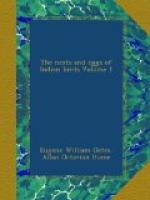The eggs are a moderately long, and generally a pretty perfect, oval, often pointed towards one end, sometimes globular, seldom, if ever, much elongated. The shell is fine and glossy, and comparatively thick and strong. The ground-colour is normally a beautiful pale greenish blue, most richly marked with various shades of deep chocolate and reddish brown. Nothing can exceed the beauty or variety of the markings, which are a combination of bold blotches, clouds, and spots, with delicate, intricately interwoven lines, recalling somewhat, but more elaborate and, I think, finer than, those of our early favourite—the Yellow Ammer. The markings are invariably most conspicuous at the large end, where there is very commonly a conspicuous confluent cap, and the delicate lines are almost without exception confined to the broader half of the egg.
Very commonly the smaller end of the egg is entirely spotless, and I have a beautiful specimen now before me in which the only markings consist of a ring of delicate lines round the large end. Some idea of the delicacy and intricacy of these lines may be formed when I mention that this zone is barely one tenth of an inch broad, and yet in a good light between twenty and thirty interlaced lines making up this zone may be counted.
The intricacy of the pattern is in some cases almost incredible, and, what with the remarkable character of the patterns and the rich and varying shades of their colours, these little eggs are, I think, amongst the most beautiful known.
Occasionally the ground-colour of the eggs, instead of being a bright greenish blue, is a pale, rather dull, olive-green, and still more rarely it is a clear pinkish white. These latter eggs are so rare that I have only seen six in about as many hundreds.
In size the eggs vary from 0.53 to 0.7 in length, and from 0.42 to 0.5 in breadth; but the average of one hundred and twenty eggs measured was 0.61 by 0.45.
467. Prinia jerdoni (Blyth). The Southern Wren-Warbler.
Drymoeca jerdoni (Blyth), Hume, cat. no. 544 ter.
Mr. Davison says:—“The Southern Wren-Warbler breeds chiefly on the slopes of the Nilgiris about the Badaga cultivation. The nest is entirely composed of fine grass, and is generally placed about 2 or 3 feet from the ground, either in a clump of long grass or attached to the branch of a small bush. It is often suspended, domed, and with the opening near the top. The eggs, generally three, are blue, spotted and lined with deep red-brown.”
From Kotagherry Miss Cockburn tells us that “the Common Wren-Warbler has no song, but is loud and frequent in its repetition of a few notes during the breeding-season. Its nest, which is globular, is built in the same shape as that of P. socialis, with the entrance at one end, on some low bush, but it only uses one material, namely fine long grass, and does not add any soft lining. The colour of its eggs, however, is totally different, of a light bluish green, and having a number of spots and streaks like dark threads carried round and through the spots, which are mostly at the thick end. The breeding-season lasts from April to July.”




